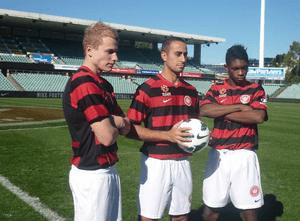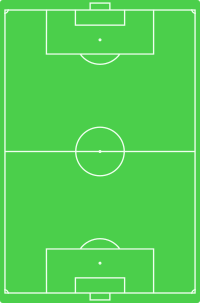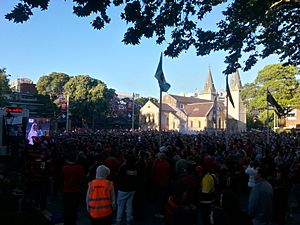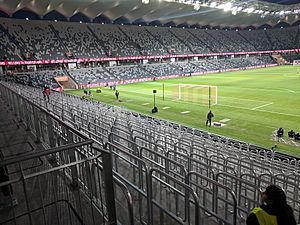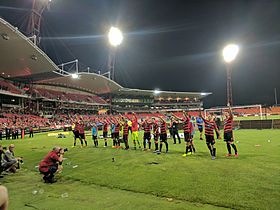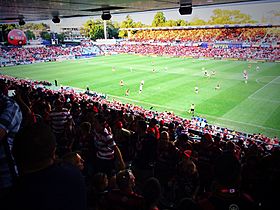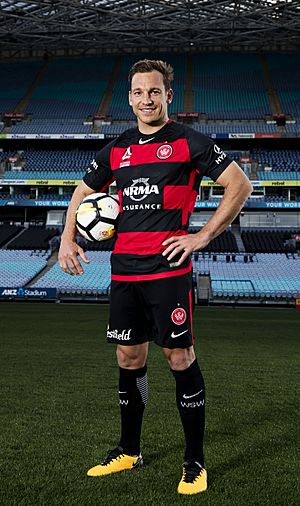Western Sydney Wanderers FC facts for kids
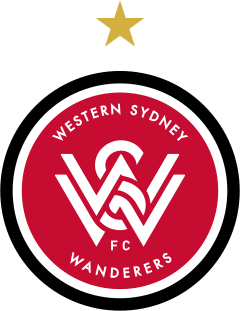 |
|||
| Full name | Western Sydney Wanderers Football Club | ||
|---|---|---|---|
| Nickname(s) | Wanderers, Red and black, Westies | ||
| Short name | WSW | ||
| Founded | 4 April 2012 | ||
| Ground | CommBank Stadium | ||
| Capacity | 30,000 | ||
| Owner | Paul Lederer, Jefferson Cheng, Glenn Duncan, David Slade | ||
| Chairman | Jefferson Cheng | ||
| Head coach | Alen Stajcic | ||
| League | A-League Men | ||
| 2022–23 | 4th of 12 | ||
|
|
|||
The Western Sydney Wanderers Football Club is a professional soccer team from Western Sydney, Australia. People often call them the Wanderers or WSW. They play in Australia's top soccer league, the A-League. The club has become very successful in Australia and Asia. They have won one A-League Premiership and the AFC Champions League title. As of 2024, they are the only Australian club to win the top Asian club competition.
The club started in April 2012. It was created with a strong focus on the community. People from Western Sydney helped choose the club's name, colours, and even its playing style. In their very first season (2012–13), the Wanderers won the A-League Premiership. They also reached the Grand Final. The next season, they finished second in the league. In 2014, they won the AFC Champions League in their first try. This made them the first Australian team to win this important Asian tournament.
The club's main office and training area are in Blacktown. They play their home games at Western Sydney Stadium. The club also has a youth team and a women's team. The youth team plays in the National Youth League. The women's team plays in the A-League Women. These teams play at different places in Western Sydney. The club even has a Powerchair Football team.
Contents
Club History
How the Wanderers Started
The idea for a soccer team in Western Sydney began around 2005. At first, Sydney FC was meant to be based there. But plans changed, and Sydney FC moved to the Eastern Suburbs. This meant Western Sydney still needed its own team.
By 2008, the league wanted to add more teams. A second Sydney team was a popular idea. After some attempts, the Football Federation Australia (FFA) decided to create a new club. This happened in April 2012. The FFA owned the club themselves at first. They even got money from the Australian Government to help start it.
Many famous Australian soccer players supported the idea. The local community also got involved. The FFA held meetings where people discussed the club's values, colours, and name. Fans voted for "Wanderers" as the team name. This name also honoured the first soccer club in Australia, Wanderers F.C., which played in the area in 1880.
On May 17, 2012, Lyall Gorman became the club's chairman. Tony Popovic was named the first head coach. He wanted to build a team from scratch. On June 25, 2012, the club's name, logo, and colours were officially announced. The first three players to sign were Aaron Mooy, Tarek Elrich, and Kwabena Appiah.
Tony Popovic's Time as Coach
First Season Success (2012–13)
Tony Popovic had to build a team quickly for the 2012–13 season. The squad included some lesser-known players and international stars like Shinji Ono from Japan. The Wanderers played their first game on October 6, 2012. It was a 0–0 draw. They won their first game three weeks later, beating Brisbane Roar 1–0.
The team started slowly but quickly became very strong. They had an amazing season, winning their first A-League Premiership. They went on a record-breaking winning streak of 10 games. This success earned them a spot in the 2014 AFC Champions League. They also reached the 2013 A-League Grand Final, but lost 0–2 to Central Coast Mariners. Popovic was named A-League Coach of the Year.
Second Season and Asian Glory (2013–14)
For the 2013–14 season, players like Brendon Santalab and Matthew Špiranović joined the team. The Wanderers stayed near the top of the league. They made their Champions League debut on February 26, 2014. They finished second in the A-League and reached their second Grand Final. They lost 1–2 to Brisbane Roar in extra time.
After the A-League season, the Wanderers continued their Champions League journey. They beat Japanese team Sanfrecce Hiroshima to reach the quarter-finals. Soon after, a group of owners bought the club. This group included Paul Lederer, Jefferson Cheng, Glenn Duncan, and David Slade.
Winning the Asian Champions League (2014–15)
Before the 2014–15 season, the club signed new players like Vítor Saba and Romeo Castelen. They lost their first FFA Cup game. But their focus was on the AFC Champions League. They beat Guangzhou Evergrande and FC Seoul to reach the final.
In the final, the Wanderers played against Al-Hilal. They won the first game 1–0 at home. On November 1, 2014, they drew 0–0 in the second game, winning the AFC Champions League 1–0 overall! This made them the first Australian team to win this huge Asian title. Tony Popovic famously said, "We were called a small club yesterday – today we are the biggest in Asia." The club and Popovic won Asian awards for their success.
However, this success didn't carry over to the A-League. The team struggled because they played so many games. They also competed in the 2014 FIFA Club World Cup in Morocco, finishing sixth. The Wanderers ended their third A-League season in ninth place. They were also knocked out of the Champions League early.
Building Again (2015–16)
Tony Popovic signed a new contract. He released almost half the squad and brought in many new players, including three from Spain. After a slow start to the 2015–16 A-League season, the Wanderers went on a seven-game winning streak. They finished second in the league.
In the finals, they had an exciting semi-final against Brisbane Roar. They won 5–4 in extra time to reach their third Grand Final in four years. However, they lost 1–3 to Adelaide United in the final. Many players left the club after this season.
Another Finals Appearance (2016–17)
The 2016–17 season started with a big loss to Sydney FC. But the Wanderers finally beat Sydney FC 1–0 in February. They also played in the Asian Champions League again but didn't make it past the group stage. They qualified for the A-League finals but lost in a penalty shootout to Brisbane Roar.
Changes in Coaching (2017–2024)
Josep Gombau's Time (2017–18)
The Wanderers started the 2017–18 season well in the FFA Cup. But then, in a big surprise, coach Tony Popovic left the club to coach in Turkey. Hayden Foxe took over temporarily.
Josep Gombau became the new manager on November 1, 2017. The team had mixed results and struggled to win many games in a row. They finished the season in seventh place and did not make the finals. Gombau was fired in April 2018.
Markus Babbel's Time (2018–20)
The Wanderers then hired former German international player Markus Babbel in May 2018. The team had a tough start to the A-League season. They improved in the second half but still missed the finals.
The 2019–20 season was their first back at the new Western Sydney Stadium. They started well, winning their first three home games, including a 1–0 victory over Sydney FC. But after a poor run of games, Babbel was sacked in January 2020. Jean-Paul de Marigny became the temporary coach.
Jean-Paul de Marigny's Time (2020)
De Marigny led the team through the rest of the 2019–20 season, which was interrupted by the COVID-19 pandemic. They didn't lose to Sydney FC that season. He was made the full-time coach in July 2020. However, he was unexpectedly sacked in October 2020.
Carl Robinson's Time (2020–22)
Carl Robinson became the new head coach in October 2020. The team's performance was inconsistent. They had a brief period in first place but then dropped down the ladder. They finished the 2020–21 season in eighth place. Robinson was fired early in the 2021–22 season after a poor start and an early exit from the FFA Cup.
Marko Rudan's Time (2022–24)
Marko Rudan took over as coach in January 2022. The team had mixed results but managed a good 2–0 win against Sydney FC. Rudan was given a longer contract.
The 2022–23 season was marked by a big rivalry with Sydney FC. Former Sydney FC star Milos Ninkovic joined the Wanderers, which caused a stir. The Wanderers started the season strong. They finished fourth and made the finals. However, they lost to Sydney FC in a thrilling derby match in the elimination final.
The 2023–24 season started well in the Australia Cup, with big wins. But their league form was inconsistent. Star striker Brandon Borrello got injured. The team's performance dropped sharply in the second half of the season, including a record 0–7 loss to Melbourne City. They missed the finals, finishing seventh. Rudan left the club in May 2024.
New Leadership (2024–Present)
In June 2024, Paul Lederer stepped down as Chairman. Jefferson Cheng took over. The club then appointed Alen Stajcic as the new head coach. Many players left the club, and new ones like Bozhidar Kraev joined. The team started the 2024–25 Australia Cup with a win.
Club Colours and Badge
The Western Sydney Wanderers' main colours are red and black. Their first uniform had red and black hoops, white shorts, and black socks. The red and black colours were very popular with fans. The club's away kit also has a hoop design, usually in white and grey.
The club's badge shows parts of the Western Sydney area, like mountains and rivers. It has the club's name and a special "WSW" pattern. After winning the 2014 AFC Champions League, a gold star was added to the top of the badge. This star shows they are Asian champions.
Club Facilities
The club's office and training facilities are all in one place at Blacktown International Sportspark. This helps everyone at the club feel connected. In 2015, the club partnered with Blacktown City Council to make the Sportspark their long-term home. They spent $15 million to build a modern training centre with many soccer fields, a gym, and recovery areas.
Stadiums
The Wanderers first played their home games at Parramatta Stadium from 2012 to 2016. Fans often called it "Wanderland." This stadium was perfect for soccer games.
In 2015, the government announced that Parramatta Stadium would be replaced. A new 30,000-seat stadium, Western Sydney Stadium, was built on the same site. During construction, the Wanderers played at Sydney Showground Stadium and Stadium Australia in Sydney Olympic Park. The new Western Sydney Stadium opened in 2019, and the Wanderers have played there ever since.
Other stadiums like Campbelltown Stadium and Penrith Stadium have also hosted some Wanderers games. The Blacktown International Sportspark is often used for the women's and youth teams. In 2019, the club opened its own boutique stadium, Wanderers Football Park, at the Blacktown facility.
Fan Support
The Western Sydney Wanderers have many passionate fans. Their main supporters' group is called the "Red and Black Bloc" (RBB). This group started in 2012 and is known for creating an amazing atmosphere at games. They are famous for their "Who do we sing for?" chant.
The RBB also does good things for the community. After the 2013 New South Wales bushfires, they raised $15,000 to help. In 2014, thousands of fans watched the AFC Champions League final together. Then, thousands more welcomed the team home at Sydney Airport after they won.
The club's membership has grown a lot since it started. In their first season, they had 7,500 members. By their third season, they had over 18,700 members.
Rivalries
Western Sydney Wanderers vs. Sydney FC
The Wanderers have a big rivalry with Sydney FC. This rivalry is one of the biggest in the A-League. It's based on the "East" versus "West" feeling in Sydney. The two teams first played each other in October 2012. Sydney FC won that first game 1–0. Later that season, the Wanderers beat Sydney FC 2–0. These games are often played in front of huge crowds and have an amazing atmosphere.
Western Sydney Wanderers vs. Macarthur FC
Another local rival for the Wanderers is Macarthur FC. This rivalry is also based on geography, as both teams are in Western Sydney. Macarthur FC is based in South Western Sydney, while the Wanderers represent the wider Western Sydney area. They first played each other in December 2020, with Macarthur winning 1–0.
Club Ownership
When the Wanderers started in 2012, the FFA owned the club. They tried to find someone to buy it, but no one did at first. So, the FFA ran the club for its first two years.
In May 2014, the FFA sold the club to a group of owners. This group was led by Australian businessman Paul Lederer, who became the chairman. Jefferson Cheng, Glenn Duncan, and David Slade were also part of this group. The new owners officially took over in June 2014.
Players
Australian A-League teams can have up to 23 players. Five of these players can be from other countries.
First-team Squad
|
|
Youth Players
These are young players who have been part of the first-team squad.
|
|
Club Leaders
Head Coaches
Here's a list of the main coaches for the Western Sydney Wanderers:
| Period | Name | Games | Won | Drawn | Lost | Win % | Honours |
|---|---|---|---|---|---|---|---|
| 2012–17 | 180 | 76 | 44 | 60 | 42.2% | A-League Premiers: 2012–13
AFC Champions League: 2014 |
|
| 2017–18 | 22 | 7 | 5 | 10 | 31.8% | ||
| 2018–20 | 48 | 15 | 8 | 25 | 31.3% | ||
| 2020 | 12 | 5 | 4 | 3 | 41.7% | ||
| 2020–22 | 35 | 11 | 11 | 13 | 31.4% | ||
| 2022–2024 | 47 | 16 | 14 | 17 | 34.04% | ||
| 2024– | 2 | 2 | 0 | 0 | 100% |
Team Captains
Here are the players who have been captain of the Wanderers:
Club Records
Mark Bridge has played the most games for the Wanderers, with 141 matches. Nikolai Topor-Stanley is second with 125 games.
Brendon Santalab is the club's all-time top goalscorer, with 41 goals. Mark Bridge is second with 38 goals.
The highest number of fans at a Wanderers home A-League game at Parramatta Stadium was 19,627 for a Sydney Derby in 2016. The most fans at any game at Parramatta Stadium was 20,053 for the 2014 AFC Champions League Final. The biggest crowd for a Wanderers home game at any stadium was 61,880 for a Sydney Derby at Stadium Australia in 2016.
Team Achievements
Season by Season Overview
Here's a quick look at the Wanderers' performance in recent seasons:
| Season | League | Finals | Australia Cup | Other competitions | Top goalscorer(s) | Coach | ||||||||||
|---|---|---|---|---|---|---|---|---|---|---|---|---|---|---|---|---|
| Division | P | W | D | L | GF | GA | Pts | Pos | ACL | CWC | Name(s) | Goals | ||||
| 2019–20 | A-League | 26 | 9 | 6 | 11 | 35 | 40 | 33 | 9th |
—
|
QF |
—
|
—
|
14 | ||
| 2020–21 | A-League | 26 | 9 | 8 | 9 | 45 | 43 | 35 | 8th |
—
|
n/a |
—
|
—
|
9 | ||
| 2021–22 | A-League Men | 26 | 6 | 9 | 11 | 30 | 38 | 27 | 10th |
—
|
R16 |
—
|
—
|
6 | ||
| 2022–23 | A-League Men | 26 | 11 | 8 | 7 | 43 | 27 | 41 | 4th | EF | PR |
—
|
—
|
13 | ||
| 2023–24 | A-League Men | 27 | 11 | 4 | 12 | 44 | 48 | 37 | 7th |
—
|
QF |
—
|
—
|
14 | ||
A-League Grand Finals Played
The Wanderers have played in three A-League Grand Finals:
| Season | Opponent | Score | Goalscorer(s) | Location | Attendance |
|---|---|---|---|---|---|
| 2013 | Central Coast Mariners | 0–2 |
—
|
Allianz Stadium, Sydney | 42,102 |
| 2014 | Brisbane Roar | 1–2* | Špiranović |
Suncorp Stadium, Brisbane | 51,153 |
| 2016 | Adelaide United | 1–3 | Neville |
Adelaide Oval, Adelaide | 50,119 |
* – Match was decided during extra time
Asian Competition Record
The Wanderers have played in the AFC Champions League, Asia's top club competition:
| Season | Competition | Round | Club | Home | Away | Aggregate |
|---|---|---|---|---|---|---|
| 2014 | AFC Champions League | Group H | 1–3 | 2–0 | 1st | |
| 5–0 | 1–0 | |||||
| 1–0 | 1–2 | |||||
| Round of 16 | 2–0 | 1–3 | 3–3 (a) | |||
| Quarter-finals | 1–0 | 1–2 | 2–2 (a) | |||
| Semi-finals | 2–0 | 0–0 | 2–0 | |||
| Final | 1–0 | 0–0 | 1–0 | |||
| 2015 | AFC Champions League | Group H | 1–2 | 3–1 | 3rd | |
| 2–3 | 2–0 | |||||
| 1–1 | 0–0 | |||||
| 2017 | AFC Champions League | Group F | 0–4 | 1–6 | 4th | |
| 3–2 | 1–5 | |||||
| 2–3 | 3–2 | |||||
Honours and Awards
The Western Sydney Wanderers have won several important titles:
Domestic Titles
- A-League Men Premiership
- Winners (1): 2012–13 (This means they finished first in the regular season)
- Runners-up (2): 2013–14, 2015–16
- A-League Men Championship
- Runners-up (3): 2013, 2014, 2016 (This is the winner of the finals series)
Continental Titles
- AFC Champions League Elite
- Champions (1): 2014 (This is the biggest club competition in Asia)
International Competitions
- FIFA Club World Cup
- Sixth-place (1): 2014 (This competition brings together the best clubs from around the world)
Special Awards
- AFC Club of the Year: 2014 (Award for the best club in Asia)
See also
 In Spanish: Western Sydney Wanderers Football Club para niños
In Spanish: Western Sydney Wanderers Football Club para niños


